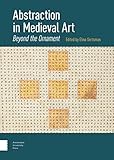Abstraction in Medieval Art : Beyond the Ornament / ed. by Elina Gertsman.
Material type: TextPublisher: Amsterdam : Amsterdam University Press, [2021]Copyright date: ©2021Description: 1 online resource (384 p.)Content type:
TextPublisher: Amsterdam : Amsterdam University Press, [2021]Copyright date: ©2021Description: 1 online resource (384 p.)Content type: - 9789048542673
- 709 23
- online - DeGruyter
| Item type | Current library | Call number | URL | Status | Notes | Barcode | |
|---|---|---|---|---|---|---|---|
 eBook
eBook
|
Biblioteca "Angelicum" Pont. Univ. S.Tommaso d'Aquino Nuvola online | online - DeGruyter (Browse shelf(Opens below)) | Online access | Not for loan (Accesso limitato) | Accesso per gli utenti autorizzati / Access for authorized users | (dgr)9789048542673 |
Frontmatter -- Table of Contents -- Acknowledgments -- Illustrations -- Preface: Withdrawal and Presence -- Part I Abstraction / Aporia / Unknowability -- 1. Colour as Subject -- 2. Abstraction’s Gothic Grounds -- 3. Abstraction in the Kennicott Bible -- 4. Back-to-Front: Abstraction and Figuration in Bosch’s Visions of the Hereafter -- Part II Abstraction / Figuration / Signification -- 5. The Painted Logos: Abstraction as Exegesis in the Ashburnham Pentateuch -- 6. The Sign within the Form, the Form without the Sign: Monograms and Pseudo- Monograms as Abstractions in Mozarabic Antiphonaries -- 7. Ornament and Abstraction: A New Approach to Understanding Ornamented Writing in the Making of Illuminated Manuscripts around 1000 -- 8. The Double-Sided Image: Abstraction and Figuration in Early Medieval Painting -- Part III Abstraction / Epistemology / Perception -- 9. Birds of Defiance: Jewelled Resistance to Modern Abstractions -- 10. Early Romanesque Abstraction and the ‘Unconditionally Two-dimensional Surface’ -- 11. Functional Abstraction in Medieval Anatomical Diagrams -- 12. Imaging Perfection(s) in Hebrew Illuminated Manuscripts -- 13. Response: Astral Abstraction -- 14. Coda: Carolingian Art As Conceptual Art -- Index
restricted access online access with authorization star
http://purl.org/coar/access_right/c_16ec
Abstraction haunts medieval art, both withdrawing figuration and suggesting elusive presence. How does it make or destroy meaning in the process? Does it suggest the failure of figuration, the faltering of iconography? Does medieval abstraction function because it is imperfect, incomplete, and uncorrected-and therefore cognitively, visually demanding? Is it, conversely, precisely about perfection? To what extent is the abstract predicated on theorization of the unrepresentable and imperceptible? Does medieval abstraction pit aesthetics against metaphysics, or does it enrich it, or frame it, or both? Essays in this collection explore these and other questions that coalesce around three broad themes: medieval abstraction as the untethering of image from what it purports to represent, abstraction as a vehicle for signification, and abstraction as a form of figuration. Contributors approach the concept of medieval abstraction from a multitude of perspectives-formal, semiotic, iconographic, material, phenomenological, epistemological.
Mode of access: Internet via World Wide Web.
In English.
Description based on online resource; title from PDF title page (publisher's Web site, viewed 03. Jan 2023)


